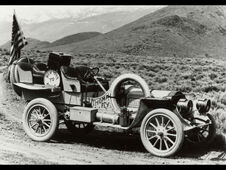| 1907 Thomas Flyer | |
|---|---|

| |
|
Origin |
1908 New York to Paris Race/ George Schuster |
|
Type |
1907 Thomas Flyer |
|
Effects |
Will always reach its destination |
|
Downsides |
Drains the energy of passengers in place of fuel |
|
Activation |
Driving |
|
Collected by |
Warehouse 13 |
|
Section |
|
|
Aisle |
N/A |
|
Shelf |
N/A |
|
Date of Collection |
March 5, 1992 |
| [Source] | |
Origins[]
The 1908 New York to Paris Race was an automobile competition consisting of drivers attempting to travel from New York to Paris. This was a considerable challenge given the state of automobile technology and road infrastructure at the time. Only three of six contestants completed the course. The winner was the United States team, driving a 1907 Thomas Flyer. The race, which was the first of its kind among automobiles, commenced in Times Square on February 12, 1908.
Six cars representing four nations were at the starting line for what would become a 169-day ordeal. The national flags of Germany, France, Italy and the United States flew, with the Protos representing Germany, the Züst representing Italy, three cars (De Dion-Bouton, Motobloc, and Sizaire-Naudin) representing France, and Thomas Flyer competing for the United States. At 11:15 AM a gunshot signaled the start of the race. Ahead of the competitors were very few paved roads, and in many parts of the world no roads at all.
The American Thomas Flyer was in the lead crossing the United States arriving in San Francisco in 41 days, 8 hours and 15 minutes. It was the first crossing of the US by an automobile in winter. At several points, forward movement was often measured in feet rather than miles per hour. Eventually, the roads improved as Europe approached and the Thomas arrived in Paris on July 30, 1908 to win. The winning driver George Schuster was inducted into the Automotive Hall of Fame on October 12, 2010.
Effects[]
The Flyer, although slow and slightly rickety, will always reach it's intended destination. To do so, however, it must drain the energy form its passengers. Each person is worth roughly ten hours of constant travel. The driver is not affected by this, but will suffer immense loss of energy upon the journeys end.

